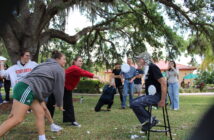
The simulator allows users to experience the delay developed when under the influence of alcohol.

The “Save a Life Tour” travels all throughout the U.S. and has even been out of the country to spread awareness.
According to the U.S. Department of Transportation, 3 people are killed in alcohol-related highway crashes every 2 hours. The consequences of driving under the influence can include arrests, property damage, injuries, and most significantly, thousands of deaths per year.
On Tuesday, Feb. 16, the “Save a Life Tour” stopped by the Saint Leo campus to not only inform students about the ample detrimental effects of driving under the influence as well as texting and driving, but to show them. Many people find that one of the most affective ways of learning about something is by experiencing it firsthand, and that is exactly what the “Save a Life Tour” does.
The tour sets up a simulator that allows students to experience exactly how it feels to be driving while under the influence of alcohol from a sober perspective. The simulator creates a delay in your response time because when you drink alcohol, regardless of your gender, everyone develops a delayed reaction. You see what is going on in front of you, your brain interprets it, and then your arms and legs react to it only after a significant delay.
“…the alcohol actually slows your processing system down. So, we put the delay that you would have if you had been drinking into the gas, the break, and the steering wheel. The person experiencing the simulator sees what’s going on from a sober perspective and how his or her brain would solve the problem of a delayed reaction if they were drunk, because there is no beating or seeing how your body would react to a delayed reaction when you’re physically intoxicated,” said “Save a Life Tour” representative Andrew Tipton.
One of the most important things to keep in mind is that you develop a delay in response time after just one drink. Obviously, the more you drink the longer the delay becomes; however, one drink is all it takes to put your life and the lives of others at risk.
The most common action of drunk drivers is going under the speed limit, which can be just as dangerous as speeding. Many people are so used to thinking that they’re okay to drive after drinking and that drunk drivers go hundreds of miles per hour, but that is not the case. They’re aware that they’re driving drunk, so they try even harder to obey the rules of the road even more than they would sober by being overly cautious. Clues to look for in drivers you suspect are drunk include swerving and stopping too far away from stop signs and intersections.
Based out of Michigan, the “Save a Life Tour” seeks out schools to come and bring awareness to students. The program has been around for approximately 15 years and travels to all 50 states and even to other countries all around the world. The tour believes itself to be “important and fun.” Its primary targets to bring awareness to include
colleges, high schools, and even military bases such as Naval, Air Force, and Marine bases.
“Kids say that it’s [experiencing the drunk driving simulator]a lot harder than they expected and I always ask myself, ‘Did you really expect drunk driving to be easy?’ and ‘What did you expect from drinking and driving?’ It’s illegal, everyone knows it, and it hurts and kills,” stated Tipton. “Something important people don’t realize about drinking and driving is that the average DUI ticket in the United States is around $10,000. Also, losing your license and even your career is very possible,” added Tipton.
“After losing someone very close to me in a car accident, I really wanted to spread the word. You don’t know how easy it is to lose control, one mistake can cost you your life,” said Trevor Laubengayer, who was in charge of the texting and driving portion of the “Save a Life Tour.”
Before students are given the opportunity to feel what it’s like to be intoxicated behind the wheel, they are encouraged to take a digital survey. Laubengayer stresses how the survey is meant to be answered truthfully, since it is important to know how many people actually text and drive.
“I’ve never felt more scared than when I was in the passenger seat until my driver was on her phone and not paying attention to the road. It felt like forever before she looked up again, and I just kept thinking ‘I want to get out of here,’” said a sophomore criminal justice major before even taking the survey. He admitted that this situation truly made him realize the danger of texting while behind the wheel.
Additional information and statistics regarding impaired driving can be found online. According to the Center for Disease Control, 112 million people drove while under the influence in 2010 alone. In 2013, drunk drivers were responsible for 31% of all traffic-related deaths in the United States. This amounted to 10,076 deaths nationwide. In Florida, between 2012 and 2013, 8,476 people died in crashes that involved a drunk driver. While the national rate of drunk driving is 1.9%, Florida’s average is slightly higher at 2.1%.
According to the National Highway Traffic Safety Administration, in 2012, 18% of all fatal crashes were related to texting and driving. In these crashes, 3,328 people were killed and 421,000 were injured. Drivers in their twenties make up 27% of the distracted drivers in these crashes. At any moment across the United States, roughly 660,000 drivers are using their phones while behind the wheel of a vehicle.
In a survey conducted by the Pew Research Center, 40% of American teens reported that they had been in a car with someone who was texting and driving at the time.
Drinking and driving as well as texting and driving are inarguably 100% preventable and not only puts your own life in danger but also the lives of every other person on the roads.




